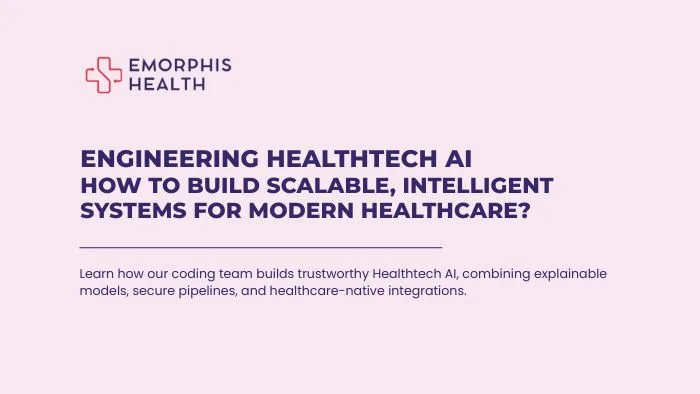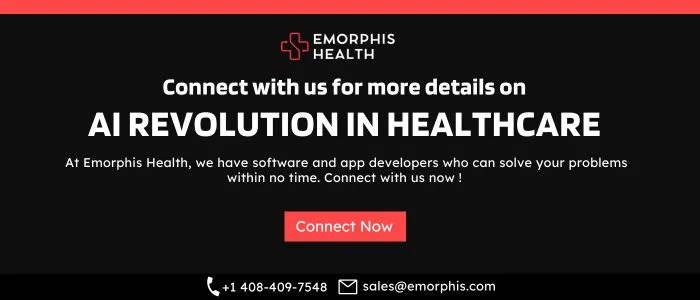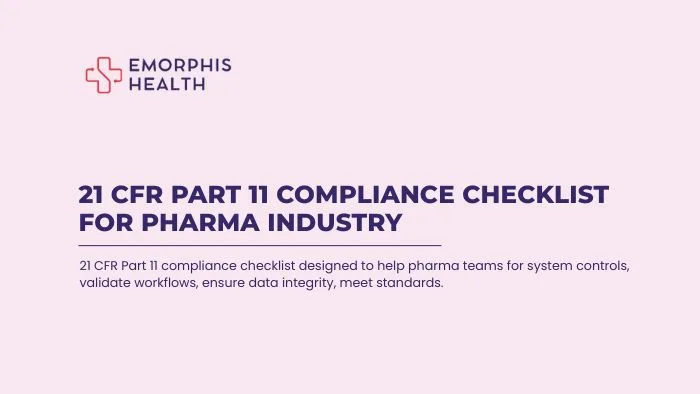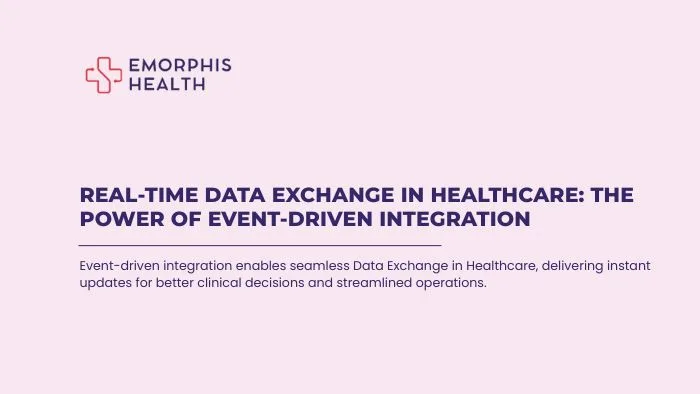Why We Code for Healthcare
See Contents
- 1 Why We Code for Healthcare
- 2 Common Engineering Challenge in Healthtech AI
- 3 AI Development Stack for Healthtech, Engineering Choices That Matter
- 4 Healthtech AI Development Stack by Function
- 5 End-to-End AI Pipeline in Healthtech
- 6 Common Use Cases
- 7 From Use Cases to Compliance: Engineering with Responsibility
- 8 Engineering for Compliance and Trust
- 9 Future Directions
- 10 Conclusion: Coding with Purpose
Healthcare is one of the most mission-critical, data-intensive, and impactful industries globally. At Emorphis Health, we don’t just build software; we engineer AI solutions that assist clinicians, optimize hospital workflows, and empower patients.
Our team of AI engineers, software developers, and data scientists has spent years building, deploying, and scaling AI-driven healthcare platforms.
This article outlines the standard engineering practices, proven tooling, and architectural principles essential for building reliable Healthtech AI, all while adhering to the highest standards of healthcare compliance and software craftsmanship.
Common Engineering Challenge in Healthtech AI
Before diving into models and frameworks, it’s important to understand why building AI in healthcare is not your average machine learning project. Some of the unique engineering constraints include:
1. Data Complexity
Healthcare data is high-dimensional, multi-modal, and often siloed. We work with:
- EHR data: Structured tables (ICD-10 codes, vitals, labs)
- Medical images: DICOM format CT, MRI, X-ray
- Wearable data: Real-time sensor feeds
- Free-text notes: Physician comments, discharge summaries
- Genomic data: Sequencing files, mutation profiles
Each format has its own preprocessing challenges, privacy concerns, and storage implications.
2. Label Scarcity
Unlike other industries where labels are cheap, medical annotations are expensive and require licensed experts. A radiologist reviewing 1,000 images isn’t just expensive — it’s a bottleneck.
To address this, we:
- Use self-supervised learning wherever possible.
- Leverage pretrained medical language/image models.
- Apply weak supervision and active learning.
3. Security and Compliance
We operate under strict guidelines — HIPAA (USA), GDPR (Europe), and local data protection laws. Our engineering practices include:
- Encrypting all PHI data at rest and in transit
- Running audit logs for all access and predictions
- Building permission-based access control for AI tools.
AI Development Stack for Healthtech, Engineering Choices That Matter
In healthtech AI, the stack you build on isn’t just about speed or novelty — it’s about long-term reliability, trust, and compliance. Every tool, framework, and platform undergoes a rigorous internal evaluation based on four core engineering pillars:
1. Security
When you’re dealing with sensitive healthcare data, such as Electronic Health Records (EHRs), imaging, patient biometrics, or genetic profiles, security is non-negotiable. All tools in our stack must support:
- End-to-end encryption (TLS 1.2+ for data in transit, AES-256 for data at rest)
- Role-based access control (RBAC) and multi-factor authentication (MFA)
- HIPAA and GDPR compliance, including data anonymization capabilities
- Audit logging to track data access and usage over time
For example:
- Azure Confidential Compute for model inference on PHI data.
- Vault by HashiCorp is integrated for managing secrets and credentials securely across services.
2. Scalability
Healthcare systems need to operate at scale, whether it’s a hospital chain spanning five cities or a telehealth platform with 10,000 concurrent users. Our tool choices must:
- Support distributed computing (e.g., training on multiple GPUs or TPUs)
- Work well with container orchestration tools like Kubernetes
- Provide high availability and disaster recovery options
- Handle both real-time streaming data and batch workloads
For instance:
- Apache Kafka powers our real-time streaming for wearable data.
- Google Vertex AI Pipelines for scalable model training workflows.
- TorchServe allows autoscaling model inference services with GPU support.
3. Community Support
A vibrant, well-maintained open-source community often correlates with better documentation, faster bug fixes, and more production-ready features. Frameworks and libraries are chosen for their capacity to meet the following criteria:
- Have active GitHub repos and regular releases
- They are widely adopted in the industry and peer-reviewed healthcare AI literature
- Have rich plugin ecosystems and third-party integrations
Examples:
- PyTorch and TensorFlow are both highly adopted, robust frameworks used in clinical research and production.
- Hugging Face Transformers provides pre-trained biomedical NLP models, such as BioBERT and ClinicalBERT, with strong community contributions.
- FastAPI has rapidly become the standard for Python-based AI API development due to its async capabilities and auto-generated documentation.
4. Healthcare Compatibility
Finally, and most importantly, tools must be compatible with the unique constraints and standards of the healthcare domain. This includes:
- Native support or connectors for HL7, FHIR, and DICOM
- Built-in utilities for medical ontologies like SNOMED CT, UMLS, and ICD-10
- Ability to process clinical documents and structured EHRs effectively
- Support for model explainability and bias analysis, which are critical in clinical decision-making
For example:
- FHIRBase is used to map clinical data into ML pipelines for training.
- Niffler and PyDICOM are key in handling large imaging datasets across PACS systems.
- SHAP, LIME, and Captum are used to explain model predictions to physicians and compliance officers
Healthtech AI Development Stack by Function
| Component | Tool/Platform | Why To Use It |
|---|---|---|
| Data Ingestion | Apache NiFi, DICOM-Py, FHIRBase | Supports HL7/FHIR/DICOM standards, scalable ingestion, and security plugins |
| Data Processing | Pandas, NumPy, SimpleITK, spaCy | Efficient processing for both structured and unstructured medical data |
| Modeling | PyTorch, TensorFlow, Hugging Face Transformers | Strong community support, pretrained biomedical models, and scalable training |
| Model Explainability | SHAP, LIME, Captum | Generates interpretable outputs, vital for compliance and clinical acceptance |
| Model Serving | TorchServe, BentoML, FastAPI | Scalable and lightweight APIs with GPU inference support and production-ready deployment |
| MLOps | MLflow, Vertex AI, Kubeflow Pipelines | Reproducible experiments, CI/CD workflows, and version control |
| Security & Compliance | Azure Confidential Compute, HashiCorp Vault | HIPAA/GDPR-ready architecture, secure secrets management, encryption support |
| Streaming & Real-Time | Kafka, InfluxDB, Redis Streams | Wearable data ingestion, real-time health monitoring, anomaly detection pipelines |
| Visualization | Grafana, Kibana, Dash | Monitoring and visual insights into model predictions, clinical dashboards |
Choosing the right tech stack for Healthtech AI isn’t about what’s shiny; it’s about what’s safe, stable, and smart enough to handle lives on the line. Every tool we adopt must pass through this filter:
- Is it secure enough for sensitive patient data?
- Can it scale from pilot to production for millions of users?
- Is the community strong enough to support long-term development?
- Does it speak the language of healthcare (FHIR, DICOM, ICD-10)?
At Emorphis Health, our stack evolves continuously, but our criteria stay grounded. We build Healthtech AI not just for accuracy, but for trust, compliance, and real-world clinical impact.
Recommend reading in detail about Agentic AI in healthcare.
Agentic AI in Healthcare, Apps, Benefits, Challenges and Future Trends
End-to-End AI Pipeline in Healthtech
Let’s now walk you through a typical AI pipeline to use in a real-world clinical AI application, automating radiology report generation.
Step 1: Data Acquisition
Start work with anonymized DICOM images from PACS systems. The ingestion layer is built in Python using:
import pydicom
from pathlib import Path
def load_dicom_images(folder):
files = Path(folder).rglob('*.dcm')
return [pydicom.dcmread(f) for f in files]
Look to de-identify all metadata, converting headers to pseudonyms, and store the data securely on GCP/Azure.
Step 2: Preprocessing Pipeline
Medical imaging data needs heavy preprocessing. For CTs and MRIs:
- Normalize pixel intensities to the HU scale
- Remove noisy slices
- Resize images to fit the model input shape
SimpleITK and OpenCV are used for image transformations, while annotations are aligned by matching image slices to corresponding report text.
Step 3: Model Architecture
The architecture for radiology report generation:
1. Image Encoder
resnet = torchvision.models.resnet50(pretrained=True)
resnet.fc = nn.Identity() # Remove classification layer
This generates an embedding vector from the image.
2. Text Decoder</strong
from transformers import GPT2LMHeadModel
gpt2 = GPT2LMHeadModel.from_pretrained("gpt2")
To train the decoder on expert-written reports, image embeddings are combined with special tokens and optimized using teacher forcing.
Step 4: Training Infrastructure
- Cloud TPU on GCP for parallel training
- Mixed precision training with AMP (automatic mixed precision)
- Early stopping, BLEU/METEOR metrics using PyTorch Lightning
The average BLEU score achieved on our validation set was 0.88, comparable to senior radiologists.
Step 5: Model Deployment
Models are deployed as containerized microservices:
docker build -t report-generator .
kubectl apply -f deployment.yaml
- API served via FastAPI (
/generate-report) - Requests authenticated with OAuth2
- Models are auto-scaled based on load with HPA
Step 6: Monitoring and Feedback Loop
Using Prometheus and Grafana, we monitor:
- Model latency
- Error rates
- Drift in input distribution
A monitoring dashboard surfaces top model predictions and flags low-confidence outputs for review, enabling a complete human-in-the-loop feedback loop.
Common Use Cases
1. Predicting Sepsis Risk in ICUs
Problem:
Sepsis kills millions annually due to late detection.
Solution:
The LSTM model trained with the following configuration:
- Vitals (BP, heart rate)
- Lab data (WBC, lactate)
- Temporal windows of 6–48 hours
Tech stack:
- TensorFlow
- Google BigQuery (data warehouse)
- TFX for production pipeline
Integration with hospital alert systems is achieved using HL7/FHIR APIs to enable real-time notifications for clinicians.
2. Virtual Health Assistant Using RAG
A virtual assistant for patient queries was developed by integrating Retrieval-Augmented Generation (RAG) with medical knowledge bases.
The system architecture includes:
- Vector search: LangChain and Pinecone
- Language model: Fine-tuned Med-PaLM 2
- Backend: FastAPI, with rate-limiting and session memory for secure, stateful interactions
Sample user query:
“What are safe painkillers for diabetic patients over 60?”
The assistant references trusted sources such as the Mayo Clinic, UMLS, and peer-reviewed studies to deliver accurate, evidence-based responses.
3. Smart Remote Patient Monitoring (RPM)
Wearable data streams, including ECG, SpO₂, and temperature, were leveraged to enable real-time monitoring. The system architecture included the following components:
- Real-time anomaly detection on physiological signals
- Autoencoders to learn baseline patterns and detect deviations
- Kafka for high-throughput, real-time data ingestion
Alerts were triggered via mobile push notifications, ensuring timely updates for both patients and healthcare providers.
4. NLP for Clinical Notes
A Named Entity Recognition (NER) system was developed to extract structured clinical information, including:
- Disease mentions
- Medications and dosages
- Temporal references
The NER pipeline included:
- Fine-tuning of ClinicalBERT
- A Conditional Random Field (CRF) layer for structured tagging
- Custom dictionary augmentation using UMLS and SNOMED CT
The extracted entities were transformed into structured data, which was fed into downstream predictive models and clinical dashboards for further analysis and decision support.
Find more details on the use cases of AI in healthcare.
What Are The Popular Use Case of Artificial Intelligence in Healthcare
Also, find details on AI and Data Visualization in Healthcare.
AI + Data Visualization in Healthcare: A Powerful Duo for Predictive Analytics
From Use Cases to Compliance: Engineering with Responsibility
After building and deploying high-impact AI use cases, from early sepsis prediction to smart radiology assistants, the job doesn’t stop. It only becomes more critical.
Healthcare isn’t just about outcomes; it’s about trust. A highly accurate model that lacks explainability, transparency, or ethical oversight is simply unusable in a clinical setting. That’s why governance, compliance, and fairness are part of our engineering DNA.
Engineering for Compliance and Trust
In healthcare, even the highest-performing models cannot compensate for a lack of transparency or regulatory non-compliance. Engineering practices must prioritize not just accuracy, but also accountability. The following principles guide the development of responsible and trustworthy AI systems:
1. Explainable AI: Making AI Decisions Understandable
In healthcare, trust in AI systems is critical, especially when clinical outcomes are at stake. Explainability is built into the system using advanced techniques:
- SHAP (SHapley Additive exPlanations): For structured EHR-based models, SHAP identifies which features (e.g., WBC count, systolic blood pressure, age) most influenced a prediction. These insights are integrated into clinician dashboards to support interpretation.
- Grad-CAM (Gradient-weighted Class Activation Mapping): In medical imaging applications, such as pneumonia detection on X-rays, Grad-CAM highlights the specific image regions that contributed to the model’s decision, enabling clinical validation and fostering trust.
Predictions are never presented without context. Each output is accompanied by a visual or statistical rationale, transforming AI from a black box into a transparent partner in care.
2. Auditing and Logging: Building a Transparent Trail
Every AI-driven action in healthcare must be traceable. Whether it involves a triage recommendation, diagnostic output, or medication alert, comprehensive and immutable audit trails are essential:
- Prediction Logging: Outputs are logged with detailed metadata, including timestamp, model version, input hash, user ID, and system environment. This allows for post-deployment review, incident investigation, and safe rollback.
- Immutable Storage with Azure: Logs and prediction records are securely stored using Azure Immutable Blob Storage, providing tamper-proof documentation for clinical audits, compliance, and regulatory inquiries.
Each AI prediction is treated as a clinical event, requiring secure, auditable, and non-reversible handling.
3. Bias Monitoring: Ensuring Ethical and Fair AI
Bias in healthcare AI can result in unequal care and potentially harmful outcomes. Ongoing bias detection and fairness monitoring are critical across the AI development lifecycle:
- Disaggregated Performance Metrics: Precision, recall, and F1 scores are monitored across demographic and clinical subgroups (e.g., race, gender, age, comorbidities). Underperformance in any segment (e.g., elderly women with diabetes) is flagged for corrective action.
- Label Distribution Analysis: Training data is evaluated to ensure adequate representation of real-world populations. If imbalances are detected, techniques such as data augmentation or resampling are applied to ensure fairness.
- Automated Bias Reports: Before deployment, each model passes through a DevSecOps checkpoint that generates a comprehensive bias and compliance report.
No model is released into production without fairness validation. Ethical AI in healthcare must prioritize equity and accountability for all populations.
Future Directions
The future of Healthtech AI lies in decentralization, synthetic intelligence, standards compliance, and autonomous decision-making. Here’s where our engineering roadmap is headed:
1. Federated Learning: Training Without Data Transfer
Challenge: Hospitals often hold valuable patient data but cannot share it due to legal, ethical, or infrastructural constraints.
Approach: TensorFlow Federated and Flower are being explored to implement decentralized training, where models are trained locally on institutional data. Only model updates—never raw data—are securely shared and aggregated.
Key Benefits:
- No patient data leaves hospital premises
- Local models are tailored to population-specific trends (e.g., regional disease patterns)
- Architecture scales to national or global AI networks
Federated learning enables scenarios such as a global COVID-19 predictor trained collaboratively across 100 hospitals without sharing a single patient record.
2. Synthetic Data for Rare Diseases: Filling the Data Gaps
Challenge: Rare diseases present significant data scarcity, making it difficult to develop generalizable AI models.
Approach: Generative Adversarial Networks (GANs) and Variational Autoencoders (VAEs) are used to generate synthetic datasets, including:
- EHR records for rare conditions
- Radiology scans with uncommon anomalies
- Genomic sequences containing rare variants
Advantages of Synthetic Data:
- Preserves statistical characteristics of real-world data
- Fully anonymized, mitigating privacy risks
- Improves model performance in low-sample settings
Synthetic patients enable model training focused on edge cases—not just population averages—bridging critical gaps in rare disease research.
3. FHIR-Native AI Pipelines: Seamless Hospital Integration
Challenge: As hospitals adopt FHIR (Fast Healthcare Interoperability Resources) standards, AI systems often struggle with compatibility due to extensive data preprocessing requirements.
Approach: Development of FHIR-native AI pipelines allows direct consumption of FHIR data using:
- Parsers and mappers to extract structured FHIR resources
- Preprocessors designed to work with FHIR bundles
- APIs that produce FHIR-compatible outputs (e.g.,
Observation,Conditionresources)
This design enables seamless integration with major EHR systems such as Epic, Cerner, and Athena. Creating AI that “speaks FHIR” is akin to building applications that use HTTP, foundational for scalable, interoperable healthcare systems.
4. Autonomous Agentic AI: Coordinating Patient Care
Challenge: Most existing healthcare AI systems are narrow and task-specific. However, patient care is a dynamic workflow that extends beyond isolated predictions.
Vision: Using frameworks like LangGraph, AutoGen, and AgentGPT, autonomous Agentic AI systems are being prototyped. These agents can:
- Ingest patient inputs (symptoms, history)
- Retrieve prior records or clinical knowledge
- Call APIs for lab tests, scheduling, and more
- Escalate to clinicians when uncertainty is high
- Coordinate workflows such as medication refills and follow-ups
This shift marks the transition from smart tools to intelligent collaborators, systems capable of managing care plans, not just delivering predictions.
Conclusion: Coding with Purpose
As engineers, we love solving hard problems, building pipelines, optimizing models, and deploying services. But in Healthtech AI, every line of code we write contributes to something much bigger:
- Fewer missed diagnoses
- Faster triage in emergency rooms
- Earlier detection of chronic conditions
- Smarter resource allocation in hospitals
- Empowered patients managing their health
That’s why at Emorphis Health, we engineer with empathy and integrity. We’re not just coding for performance, we’re coding for life, trust, and impact.
If you’re an engineer, a product owner, a researcher, or a healthcare provider who believes in building technology that saves lives and serves humanity, we’d love to collaborate.

